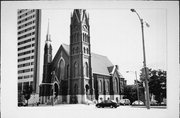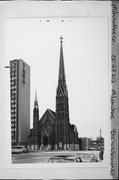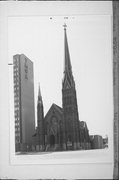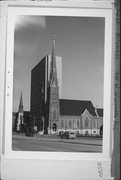| Additional Information: | A 'site file' exists for this property. It contains additional information such as correspondence, newspaper clippings, or historical information. It is a public record and may be viewed in person at the Wisconsin Historical Society, State Historic Preservation Office.
HABS WI-264.
Artist: (Frescoes) John H. Harding.
Builder: Simeon Babcock.
DESCRIPTION:
Calvary Presbyterian is a Victorian Gothic church building. It is a rectangular structure with the church proper measuring 70 feet wide and 150 feet long. It sits on a raised foundation of rock-faced coursed ashlar limestone. The nave is one continous space that rises 85 feet and is topped with a steeply pitched gable roof that is intsected with shallow gable transepts. Pressed metal copings and Gothic corbelling accent the parapets.
The church is constructed of Milwaukee cream brick and is trimmed with Ohio sandstone. All masonry surfaces have been painted red. The main facade is dominated by two towers that terminate in slender spires. The larger one at the nortwest corner rises 202 feet. The tower is framed with buttresses which terminate in pinnacles with crockets. The slate clad spire is trimmed with pressed metal ribbing and crowned with a Latin cross. The smaller tower at the northeast corner rises 105 feet and is also framed with buttresses and has a spire sheathed with pressed metal.
The windows have pointed arches and are inset with leaded and/or stained glass. The most decorative of these is the rose window on the main facade. It is inset within a larger arched window that is trimmed with a heavy sanstone hood mold and embellished with crockets. Below the rose window is the main entry. Reached by a double-flight of stairs, the double doors are trimmed with wrought iron strap work hinges and deeply recessed under a gabled brick porch that is framed by buttresses that terminate with "Calvary Presbyterian" in raised letters. The side walls of the church are divided into bays by buttesses similar to those on the towers and entry porch.
Calvary Presbyterian is located at the western edge of Milwaukee's central business district on W. Wisconsin Avenue in what was once an exclusive residential area. The formal Mitchell House, located across the street, attests to the past elegance of the neighborhood. The church occupies almost all of its site and there is no landscaping.
Changes to the main body of the church have been minimal. To the rear of the building several additions have been made. In 1910 a one-story brick addition was made to the southwest corner. This housed the pastor's study and church office. In 1947 a fire did considerable damage to the south end of the church. This necessitated the rebuilding of the sanctuary and extensive repairs to the nave and nave roof. In 1957-58 a two-story classroom wing was added on the southeast corner of the building and an elevator shaft was built near the north-east corner.
The interiors were not visited.
ARCHITECTURAL/ENGINEERING SIGNIFICANCE:
Normally religious properties are excluded from listing in the National Register, but Calvary Presbyterian Church is locally significant as an important example of Victorian Gothic religious architecture. Built in 1870, it is one of the best preserved Gothic churches in the city from the period immediately following the Civil War. It is the second oldest extant church building on the West Side and one of Milwaukee's oldest in continuous use. The church was designed by master Milwaukee architect, Henry C. Koch, in association with Julius Hess. Koch had been under the tutorship of G. W. Mygatt, the most prolific of the city's pre-Civil War architects, from 1856 to 1862. Koch enlisted in the Union Army and served as a topographical engineer. After the war, he returned to Mygatt's office in 1866 as his partner and remained there until 1870.
It is likely that Calvary was Koch's first major independent work. Koch employed not only the best available craftsmen of the period - including Simeon Babcock as the builder and John H. Harding as the painter of the Frescoes (B) - but also used the highest quality materials to produce a structure that ranks among Milwaukee's best churches. (C).
HISTORICAL BACKGROUND:
The West Side's only Presbyterian congregation, Calvary was established to serve the needs of the areas early Yankee settlers. The first Presbyterian church in Milwaukee had been founded by the Reverend Cutting Marsh in 1837. Services were held for the 18 members in the county courthouse for a few years until the congregation was declaired illegal because it failed to comply with the State statutes. The congregation reorganized in 1840 and met briefly as the First Presbyterian Society at 2nd and Wells Street before building a permanent structure at the corner of East State and Milwaukee Streets on the East Side in 1842. By 1849 Milwaukee's burgeoning population necessitated the establishment of a second church, North Presbyterian, at North Milwaukee and East State Streets.
By 1869, the West Side residents wanted their own church. As a result, John Plankinton, H. H. West, Joseph B. Bradford and A. B. Clever resigned from the original First Presbyterian Church to form a new church. At a meeting held in March of 1869, a new Presbyterian society was established with the name of Calvary. Its initial membership includes 51 persons originally from First Presbyterian and 12 from North Presbyterian. John Plankinton, James B. Bradford and Samuel C. West, all wealthy businessmen, were elected the first officers.
Calvary first met in the old Greek Revival style structure previously used by St. James Episcopal Church. The building was sold back to St. James when the current Calvary was completed in 1870 at a cost of $60,000. The size and opulence of the new Gothic style structure was a testament to the affluence of the fledgling congregation, which was drawn from the city's Yankee elite. The church continues to house the much-reduced in size decendent of its original congregation. (C). |
|---|
| Bibliographic References: | A. Milwaukee City Building Permits.
B. Pagel, Mary Ellen. "Calvary Presbyterian Church," unpublished Historic American Buildings Survey Report, Milwaukee, 1968. (The architects and the date of construction are from the 1968 HABS Report).
C. Flowers, Frank. History of Milwaukee, Chicago: Western Historical Co., 1881 pp. 829-832, 1500-01.
D. MILWAUKEE HISTORIC BUILDINGS TOUR: KILBOURNTOWN, CITY OF MILWAUKEE DEPARTMENT OF CITY DEVELOPMENT, 1994.
E. See Historic American Buildings Survey (HABS) Report (1968)
Pagel, Mary Ellen & Virginia A Palmer, University Extension The University of Wisconsin, Guides to Historic Milwaukee: Kilbourntown Walking Tour, 1967. |
|---|





